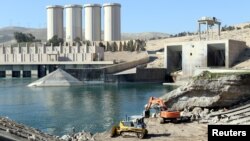Iraq's Mosul dam, already the world's most dangerous, is increasingly at risk of a spectacular failure that would deluge millions of people downstream, according to a U.S. study released by the Iraqi parliament.
The dam was built on an unstable foundation that is constantly eroding, and a lapse in maintenance after the Islamic State (IS) extremist group briefly seized it in 2014 has weakened the already flawed structure.
"All information gathered in the last year indicates Mosul dam is at a significantly higher risk of failure than originally understood and is at a higher risk of failure today than it was a year ago," the study by the U.S. Army Corps of Engineers said.
Since the dam's completion in 1984, the Iraqi government has continuously shored up the foundation by injecting cement into sinkholes that developed under the massive structure.
Grouting has resumed since the dam was retaken from the militants, but not as frequently as needed because IS maintains control over of a nearby factory that produces the concrete for the dam.
"The reduction in grouting capacity for the past year has almost certainly resulted in an unprecedented level of untreated voids in the foundation from the continued dissolution and erosion of the geology," the U.S. Corps said.
Iraq has awarded Italian firm Trevi a contract to repair and maintain the dam, and Italy's premier has said the country would send 450 troops to defend the structure.
But their work will provide only a temporary solution to the problem, engineers say.
Since 2007, U.S. officials have been warning of devastating results if the dam suffers a catastrophic failure and unleashes a flood from the 30-mile lake behind the dam.
U.S. officials have predicted a 20-meter flood wave would hit the city of Mosul and its 700,000 residents 60 kilometers downstream, and Tigris River flooding would be felt as far away as Baghdad, 500 kilometers downstream.
More than half a million people could be killed and millions more would be driven from their homes, they estimate.
U.S. Army Lieutenant General Sean MacFarland told reporters in Baghdad last month that U.S. engineers don't know exactly when the dam could collapse, but believe it could happen any time.
"All we know is when it goes, it's going to go fast and that's bad," he said.









